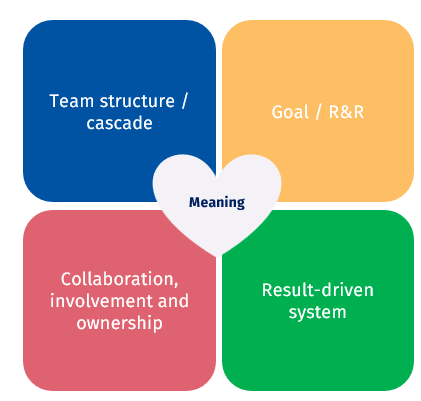Obeya is a methodology and, more importantly, a mindset that places the right responsibilities at the right levels within an organisation. This allows each team to have its unique, visual, and results-driven playing field. In this blog, discover how Stanwick utilises this approach in future-proof transformations. In part 1 of this series, we start at the beginning, why use Obeya in your organisation, what is Obeya and how to implement Obeya.
Facts why Obeya makes sense to implement in your organisation
Fact 1: Organisations struggle with growing complexity
Everything has become more complex. By everything, we mean the challenges organisations face: information flows, unstoppable digitisation, competition, and the accompanying innovative and cost-reducing demands. The issue of personnel has also become increasingly complex: attracting and retaining talent, changing employee mentalities and expectations, and the unprecedented speed at which we must adapt. It's no longer something we need to write down; it's a fact. Everyone knows, feels, and experiences it.
Fact 2: Organisations struggle with low engagement and lack of oversight
However, many organisations struggle to drastically change their way of working, decision-making, and handling complexity from the ground up. Leaders become overwhelmed or sandwiched, the response time is low, and actions are taken at a higher level within the organisation. As a result, there is little involvement from shop floor teams, and the overview is lost.
Conclusion: Now is the time to change for organisations and become future-proof
How wonderful would it be to work in an organisation where:
- Leadership exists at every level of the organisation.
- Involvement and ownership are present in every team.
- Decision-making and action-taking have a high response time.
- There is a clear and visual overview of goals, priorities, results, actions, and responsibilities.
- Healthy collaboration exists among teams working collectively towards a common goal.
- The focus is on meaningful work, allowing employees and teams to continue learning.
Would you like to be part of such an organisation? The solution is "team autonomy with Obeya."
What is Obeya?
Obeya originated in the 1990s at the Japanese company Toyota. They applied this methodology in the construction of the Prius, resulting in the model being brought to market in half the projected time. The Japanese word Obeya literally means "big room." In this big room, we bring together all levels of the organisation, from management to the shop floor, around one truth. It links strategy and operations by translating strategic objectives into tangible work goals for each team. Within this big room, we find a visual and clear overview of the process, current status, and team results. It allows for ownership to be taken so that the right decisions are made by the right people at the right time. It creates a new way of collaboration within and between autonomous teams.
How do you implement Obeya in organisations?
The road to implement Obeya is not a highway.
Stanwick has translated this methodology into a concrete approach that goes beyond just "the tool." Stanwick believes that a transformation can only be successful when structure, process, system, and culture go hand in hand. In an Obeya transformation, we work on 4 foundations:

Obeya foundation 1: Team structure and cascade
How do we structure multidisciplinary teams in our organisation? How do we enable them to collaborate efficiently and escalate issues easily?
Obeya foundation 2: Goals, roles, and responsibilities
How can we empower teams to make the right decisions? How do we create clarity in their playing field?
Obeya foundation 3: Collaboration, involvement, and ownership
How can we encourage everyone to work according to the Obeya mindset and take ownership? What is our team's manifesto? How do we want to collaborate, and what do we expect from each other?
Obeya foundation 4: Result-driven system
Such a system can motivate and challenge us to achieve results and continuously improve. It compels us to follow standards and do things the right way. It ensures the sustainability of our new way of working.
When we work on these four foundations and gradually help teams embrace this mindset, a sense of purpose emerges. Employees feel connected to the organisation's purpose, empowered to take action, and understand what is expected of them. With this mindset, the organisation's learning capacity will continue to grow.
In the next four parts, we will guide you through each of these four foundations. What are the keys to success, and what are the pitfalls?
Obeya - what is the team structure and escalation structure? Read more in part 2
Obeya - what are the roles? Read more in part 3
Obeya - what type of leadership do we expect? Read more in part 4
Obeya - how do we setup the Obeya room? Read more in part 5
Curious for more? Keep following us.
Do you have a specific question? Take a look at our website or contact us. Stanwick supports you in your future-proof transformation!





